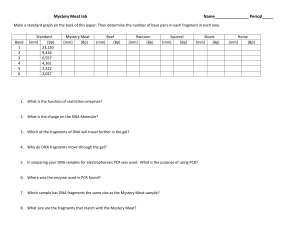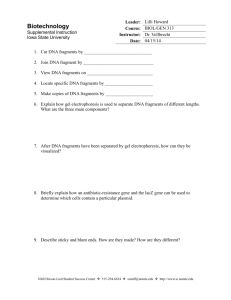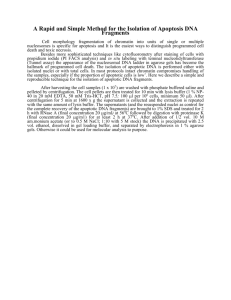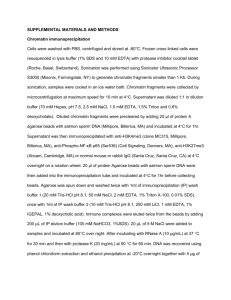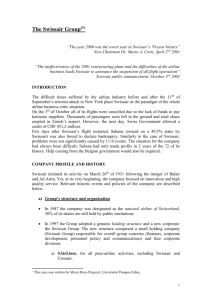Media Watch - International Aviation Safety Organization
advertisement
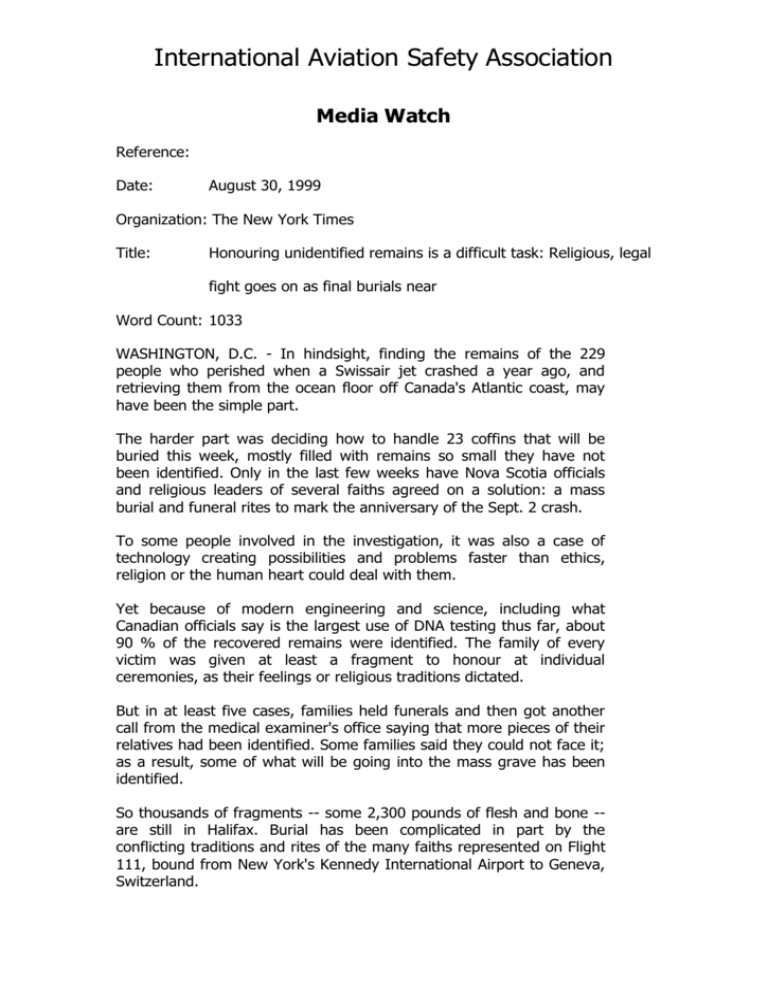
International Aviation Safety Association Media Watch Reference: Date: August 30, 1999 Organization: The New York Times Title: Honouring unidentified remains is a difficult task: Religious, legal fight goes on as final burials near Word Count: 1033 WASHINGTON, D.C. - In hindsight, finding the remains of the 229 people who perished when a Swissair jet crashed a year ago, and retrieving them from the ocean floor off Canada's Atlantic coast, may have been the simple part. The harder part was deciding how to handle 23 coffins that will be buried this week, mostly filled with remains so small they have not been identified. Only in the last few weeks have Nova Scotia officials and religious leaders of several faiths agreed on a solution: a mass burial and funeral rites to mark the anniversary of the Sept. 2 crash. To some people involved in the investigation, it was also a case of technology creating possibilities and problems faster than ethics, religion or the human heart could deal with them. Yet because of modern engineering and science, including what Canadian officials say is the largest use of DNA testing thus far, about 90 % of the recovered remains were identified. The family of every victim was given at least a fragment to honour at individual ceremonies, as their feelings or religious traditions dictated. But in at least five cases, families held funerals and then got another call from the medical examiner's office saying that more pieces of their relatives had been identified. Some families said they could not face it; as a result, some of what will be going into the mass grave has been identified. So thousands of fragments -- some 2,300 pounds of flesh and bone -are still in Halifax. Burial has been complicated in part by the conflicting traditions and rites of the many faiths represented on Flight 111, bound from New York's Kennedy International Airport to Geneva, Switzerland. International Aviation Safety Association DNA analysis could probably be used to identify virtually all the fragments, and there was considerable pressure to do just that. "We have the capacity to do extraordinary things," said John O'Donnell, the director of administration at the Roman Catholic Archdiocese of Halifax, reflecting on the DNA analysis and marine salvage technology. "Then there's this relentless, inevitable trudging on to complete things as fully as possible." But John Butt, the Nova Scotia Medical Examiner, said that with divers recovering fragments by the thousands, he had to draw the line well short of analyzing everything. Otherwise, he said, the Royal Canadian Mounted Police would have faced a backlog of cases and been unable to solve rapes and murders or to identify victims of other crashes and crimes. And burial of the Swissair remains could have been delayed for years. Most families supported Dr. Butt's decision to stop the DNA testing, but some families were distraught. Plans for the mass burial have created problems, too. O'Donnell helped design a service with a committee of Anglican, Muslim, Greek Orthodox, Presbyterian and Jewish clergy members, whose burial rites are often incompatible. Lyn Romano, of Goldens Bridge, N.Y., whose husband, Ray, was on the plane, called the mass burial plan "an atrocity." She said "time and money" were all that was needed to identify more remains and Swissair had a moral obligation to provide both. Dr. Butt said there was no Canadian law to guide him in deciding when to cease identification, but he did find one relevant religious rule. Rabbis advising him said the Talmud, which predates the discovery of DNA by more than 1,000 years, specifies that fragments too small for their source in the body to be determined do not have to be linked to a specific person. Dr. Butt drew a similar line at human remains too small to identify anatomically, but he said, "Moral issues are tough to deal with in the law, and tough to deal with administratively." The problem is not unique to Halifax. The Armed Forces Institute of Pathology in Bethesda, Md., intermittently receives shipments of 100 or 200 fragments of bone from 30-year-old plane wrecks in Vietnam, often involving cases where the records indicate there were two crewmen. International Aviation Safety Association "You do DNA on the first 15 or 20 pieces, and it indicates they're all from the same person," said Lt. Col. Brion Smith, the chief deputy medical examiner. "So you do another 15 or 20, and it's still from one person. How long do you keep on going, using your resources, to look for that second person who may not be there?" The nature of the Swissair crash added to the problems in Halifax. Unlike the TWA Flight 800 crash, which also occurred at sea, the Swissair crash caused extensive fragmentation. The TWA plane, a Boeing 747, broke up in flight. While many bodies were mangled, they remained mostly intact because of the speed and angle at which the plane entered the water, according to people involved in the accident investigation. Frank Carven, a vice-president of the Families of the TWA Flight 800 Association, said that as a result the recovery of unidentified body parts was less of an issue. In the crash of a USAir 737 near Pittsburgh in 1994, which also involved virtual disintegration, the airline buried several coffins of mixed parts without notifying the families. The incident was one reason that Congress put the National Transportation Safety Board in charge of co-ordinating the treatment of families in crashes in this country. In Halifax, Dr. Butt used fingerprints, jewelry, dental records and tattoos to identify many body fragments, and then DNA to match other fragments to them. More than 100 people were identified by DNA alone, and about 1,400 body fragments were analyzed. Mr. O'Donnell of the archdiocese said many Christians assumed that the remains would be cremated, but the Muslim and Jewish clergy members objected. Coffins were another issue. Jewish tradition is to use only wood, unadorned and without nails. Such coffins eventually deteriorate. Nova Scotia officials insisted on metal coffins that could be exhumed later if necessary. Several memorial events will be held in Halifax this week, including one in which relatives can meet the people who aided in the recovery. But it will not end there. The Transportation Safety Board of Canada, still investigating the crash, plans to carry out several more days of dredging, looking for more pieces of the cockpit. That, Dr. Butt expects, will turn up more remains. International Aviation Safety Association
